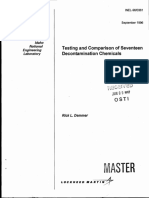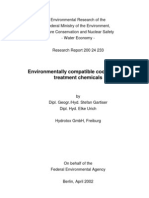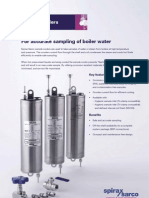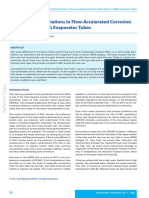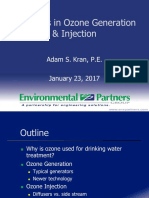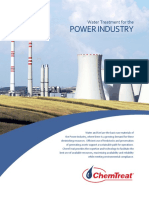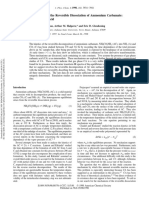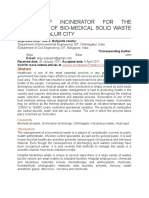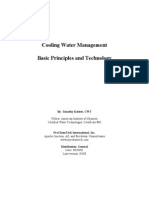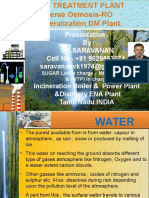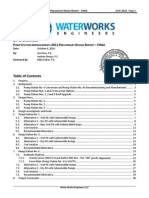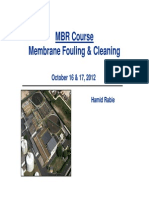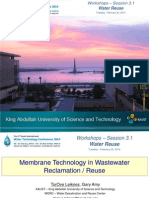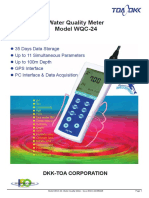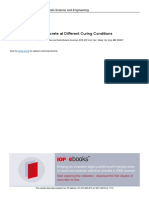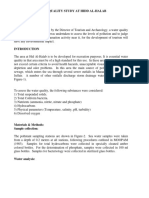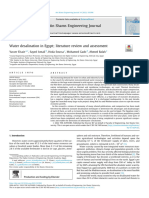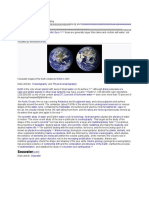0 ratings0% found this document useful (0 votes)
195 viewsAntiscalant Patel Des 1999
Antiscalant Patel Des 1999
Uploaded by
Alfonso José García LagunaNew products based on enhanced maleate chemistry have been developed to control the broad range of deposits found in thermal desalination plants. Laboratory tests were developed to measure the control of fouling species. Six months' data from a 23,000m 3 / d plant in Saudi Arabia, operated at a top brine temperature of 110degC, will be presented.
Copyright:
© All Rights Reserved
Available Formats
Download as PDF, TXT or read online from Scribd
Antiscalant Patel Des 1999
Antiscalant Patel Des 1999
Uploaded by
Alfonso José García Laguna0 ratings0% found this document useful (0 votes)
195 views13 pagesNew products based on enhanced maleate chemistry have been developed to control the broad range of deposits found in thermal desalination plants. Laboratory tests were developed to measure the control of fouling species. Six months' data from a 23,000m 3 / d plant in Saudi Arabia, operated at a top brine temperature of 110degC, will be presented.
Copyright
© © All Rights Reserved
Available Formats
PDF, TXT or read online from Scribd
Share this document
Did you find this document useful?
Is this content inappropriate?
New products based on enhanced maleate chemistry have been developed to control the broad range of deposits found in thermal desalination plants. Laboratory tests were developed to measure the control of fouling species. Six months' data from a 23,000m 3 / d plant in Saudi Arabia, operated at a top brine temperature of 110degC, will be presented.
Copyright:
© All Rights Reserved
Available Formats
Download as PDF, TXT or read online from Scribd
Download as pdf or txt
0 ratings0% found this document useful (0 votes)
195 views13 pagesAntiscalant Patel Des 1999
Antiscalant Patel Des 1999
Uploaded by
Alfonso José García LagunaNew products based on enhanced maleate chemistry have been developed to control the broad range of deposits found in thermal desalination plants. Laboratory tests were developed to measure the control of fouling species. Six months' data from a 23,000m 3 / d plant in Saudi Arabia, operated at a top brine temperature of 110degC, will be presented.
Copyright:
© All Rights Reserved
Available Formats
Download as PDF, TXT or read online from Scribd
Download as pdf or txt
You are on page 1of 13
Presented at the Conference on Desalination and the Environment, Las Palmas, Gran Canaria, 912 November, 1999.
European Desalination Society and the International Water Association.
0011-9164/98/$09.50 1998 Elsevier Science B.V. All rights reserved
Desalination 124 (1999) 6374
New antifoulants for deposit control in MSF and MED plants
Suresh Patel*, Michael A. Finan
Process Additives Division, FMC (UK) Corporation Ltd., Tenax Road, Trafford Park, Manchester M17 1WT, UK
Tel. +44 (161) 872-2323, ext. 3350; Fax +44 (161) 875-3171/5
Abstract
New products based on enhanced maleate chemistry have been developed to control the broad range of deposits
found in thermal desalination plants. To investigate the performance characteristics of enhanced maleate products,
laboratory tests were developed to measure the control of fouling species. The test methods developed for and used
in this study provide a further understanding of the key mechanisms of deposit control by additives. The advance
performance of products based on enhanced maleate chemistry compared with conventional products currently in
use in MSF and MED plants will be presented. Individual product data sets have been combined to produce product
performance profiles which can then be used in the selection of additive appropriate to the fouling characteristics of
the desalination plant. The enhanced maleates have been successfully tried in both MSF and MED plants. Six months
data from a 23,000m
3
/d plant in Saudi Arabia, operated at a top brine temperature of 110C, will be presented. Also
12- month operational data from an 8000m
3
/d MED plant in Europe, top brine temperature 62C, will be presented.
The results from these extended field evaluations have confirmed the initial laboratory results.
Keywords:Calcium carbonate; Magnesium hydroxide; Seawater; Scale; Inhibitor; Dispersant; Desalination; MSF;
MED; Belgard EV2030; Belgard EV2050; Field trials
1. Introduction
The main process for production of pure wa-
ter from seawater is currently practiced by multi-
stage flash (MSF) and multi-effect desalination
(MED). The major problem encountered is the
deposition of scale onto the heat transfer surfaces
*Corresponding author.
which results in a serious loss of efficiency and
production [1]. Without effective scale control,
this can lead to the eventual shutdown of the plant
for cleaning.
The scales that are generally encountered can
be divided into two main classes: (1) alkaline
scales, e.g., calcium carbonate and magnesium
hydroxide and (2) non-alkaline scales, e.g., cal-
cium sulphate.
S. Patel, M.A. Finan / Desalination 124 (1999) 6374 64
The alkaline scales result from the thermal de-
composition of bicarbonate ion present in sea-
water.
2HCO
3
-
====> CO
3
2-
+ H
2
O + CO
2
(1)
The calcium ions present in the seawater react
with the carbonate ions to form calcium carbon-
ate.
Ca
2+
+ CO
3
2-
====> CaCO
3
(2)
Furthermore, the carbonate formed in reaction (1)
may react with water in the following manner:
CO
3
2-
+ H
2
O ====> CO
2
+ 2OH
-
(3)
The hydroxyl ions formed can react with magne-
sium present in the seawater to form magnesium
hydroxide:
Mg
2+
+ 2OH
-
====> Mg(OH)
2
(4)
The rate of formation of calcium carbonate and
magnesium hydroxide in seawater depends on
temperature, pH, concentration of bicarbonate
ions, rate of CO
2
release, concentration of Ca
2+
and Mg
2+
ions, and total dissolved solids. Calcium
carbonate is the major scale that is formed up to a
seawater temperature of 90C, whereas magne-
sium hydroxide is mainly formed above tempera-
tures of 95100C. This is due to the increase in
formation of hydroxyl ions with increasing tem-
perature [see Eq. (3)]. Also, calcium carbonate
and magnesium hydroxide possess low solubilities
and have an inverse solubility, that is with in-
creasing temperature their solubility decreases.
The non-alkaline scale found is calcium sul-
phate which exists in three forms: anhydrite
(CaSO
4
), hemihydrate (CaSO
4
1/2H
2
O) and dihy-
drate (CaSO
2
2H
2
O). All these forms of calcium
sulphate are more soluble than calcium carbonate
and magnesium hydroxide, and will form when
the seawater is supersaturated with respect to
calcium sulphate.
Marshall and Slusher [2] determined the solu-
bilities of the three forms of calcium sulphate at
different temperatures and different seawater
concentration factors. These results may be used
to estimate under what conditions an MSF plant
can be operated before calcium sulphate scaling
becomes a problem. Hence in most MSF plants,
calcium sulphate scaling is prevented by con-
trolling the temperature and concentration factor
of the brine within the precipitation limits, that is
a maximum temperature of 120C and a concen-
tration factor of 2 based on standard seawater.
Another foulant that can occur is by the in-
gress of fine silt usually when the seabed is dis-
turbed during rough sea conditions, dredging
activities, etc. [3]. This increases the suspended
solids content of the feed seawater and can cause
blockages of pumps, pipework and deposition on
heat transfer surfaces. The silt can also combine
with calcium carbonate and/or magnesium hy-
droxide forming a mixed scale. In addition, some
antiscalants adhere strongly to silt by adsorption,
hence reducing the concentration of the additive
in the bulk solution to control chemical fouling,
e.g., calcium carbonate and magnesium hydrox-
ide. This could lead to severe fouling of the plant
if the additive concentration is not increased.
To control this scaling problem on heat trans-
fer surfaces in MSF and MED plants, the follow-
ing methods may be used: (a) acid treatment, (b)
additive treatment, and (c) mechanical cleaning.
The first method involves the addition of acid
which undergoes the following reactions:
HCO
3
-
+ H
+
====> H
2
O + CO
2
This method of scale control is effective but has a
number of drawbacks. These are:
S. Patel, M.A. Finan / Desalination 124 (1999) 6374 65
1. Stoichiometric amounts of acid must be
added to the seawater; usually a large quantity of
acid is required and is hazardous.
2. Addition of excess acid would give rise to
corrosion problems [4].
3. From Eq. (5), large volumes of CO
2
are re-
leased, hence additional equipment in the form of
a decarbonator is required to remove the CO
2
produced.
Due to these drawbacks, the second method is
more practical. Chemical additives are used to
control the formation of scale by having threshold,
crystal growth inhibition and crystal distortion
properties. The threshold properties may be de-
fined as maintaining the calcium and magnesium
ions in solution. Some of these threshold additives
have a marked effect on the crystal habit of the
scaling compound, such that the crystal either
stops growing or is distorted. The distorted crys-
tals are less likely to adhere to each other and to
metal surfaces. Polymers based on polycarboxylic
acid type chemistry also have the additional ad-
vantage of having dispersion properties of calcium
carbonate, magnesium hydroxide and silt. Poly-
mers can adsorb onto the particulate surfaces and
impart a like charge, hence repelling neighbouring
particles, thereby keeping the particles suspended
in solution.
The chemical additives that are currently in
use have one or more of these properties. These
are polyphosphates, phosphonates, polyacrylates
and polymaleates. They are either used on their
own or in combination with a mechanical cleaning
method, namely sponge ball cleaning. The latter
method removes any soft scale (which is formed
in the presence of an additive) that is deposited on
a heat transfer surface [5,6].
Polyphosphates are rarely used in MSF and
MED plants as these tend to cause additional scale
in the form of thick muddy deposits [7] as calcium
phosphate or mixed scale including phosphate
ions, which can strongly adhere to the heat trans-
fer surfaces and is difficult to remove.
In this study a new range of antifoulants, en-
hanced maleates [8], have been studied and com-
pared to the conventional additives currently in
use. In order to compare these additives, a number
of tests were designed to provide not only the
performance characteristics of the individual
additive but also to identify the key mechanism by
which these additives retard scale under desalina-
tion conditions.
The objective of this work was to generate per-
formance profiles of individual additives such that
the appropriate additive can be matched to the
fouling characteristics of the desalination plant
and field tested on MSF and MED plants.
2. Experimental
2.1. Calcium carbonate deposition test
This test measures the additives ability to
control calcium carbonate deposition by three
mechanisms: (1) threshold, (2) nucleation at the
heated metal surface and (3) crystal growth inhi-
bition at the metal surface.
This test method utilizes a synthetic seawater
(Table 1). This water, containing an additive, is
pumped at constant flow rate through a coil 1.1
mm (ID) 316 stainless steel capillary tube
Table 1
Synthetic seawater chemistry used in calcium carbonate
deposition test
Calcium, mg/l as Ca
2+
Magnesium, mg/l as Mg
2+
Chloride, mg/l as Cl
-
Sodium, mg/l as Na
+
Carbonate, mg/l as CO
3
2-
Sulphate, mg/l as SO
4
2-
Potassium, mg/l as K
+
Total dissolved solids, mg/l
pH
400
1,200
18,711
10,522
184
2,623
395
34,037
8.6
S. Patel, M.A. Finan / Desalination 124 (1999) 6374 66
Fig. 1. Calcium carbonate deposition test rig.
immersed in water bath at 90C. Any calcium
carbonate deposition reduces the bore of the tube
and causes an increase in pumping pressure. The
rate of change in pressure across the capillary tube
was monitored by a pressure transducer and plot-
ted against time on a chart recorder. Two mg/l of
additive was maintained during the test, and the
time to reach a P of 1psi (6.895kPa) was meas-
ured. The set-up of this equipment is shown in
Fig. 1. The greater the time to reach P of 1psi,
the better the additive at controlling calcium
carbonate deposition.
2.2. Calcium carbonate crystal growth inhibition
test
This test is designed to measure the additives
ability to stop the growth of calcium carbonate
crystals in the bulk solution phase. A 100 cm
3
synthetic water (Table 2) containing 20mg of
calcium carbonate crystals was placed in a water
bath at 85C for 30 min. The solution was filtered
through a 0.45 filter and the soluble calcium
determined in the filtrate by titration with EDTA.
This test was repeated with 4 mg/l additive pres-
ent. Also a standard solution was made containing
no carbonate ions and the above test repeated. To
calculate the percentage inhibition of each addi-
tive, the following equation was used:
% inhibition = ([Ca
2+
]
Additive
- [Ca
2+
]
Blank
/
[Ca
2+
]
Standard
- [Ca
2+
]
Blank
) 100
where [Ca
2+
]
Additive
is the concentration of soluble
Ca
2+
in an additive-containing solution (mg/l),
Table 2
Synthetic seawater chemistry used in the crystal growth
inhibition test
Calcium, mg/l as Ca
2+
Magnesium, mg/l as Mg
2+
Chloride, mg/l as Cl
-
Sodium, mg/l as Na
+
Carbonate, mg/l as CO
3
2-
Total dissolved solids, mg/l
pH
125
375
19,290
11,940
181
31,911
8.8
S. Patel, M.A. Finan / Desalination 124 (1999) 6374 67
[Ca
2+
]
Standard
is the concentration of soluble Ca
2+
in
a standard solution (mg/l), and [Ca
2+
]
Blank
is the
concentration of soluble Ca in a blank solution
(mg/l). The higher the percentage inhibition, the
better the crystal growth inhibition of calcium
carbonate.
2.3. Magnesium hydroxide inhibition test
This test measures the threshold properties of
additives to control magnesium hydroxide.
One thousand cm
3
seawater (Table 3) was
heated to 90C while the pH was maintained at 8
throughout the 30 min test. The turbidity of the
solution at the end of the test was measured using
a Hach spectrophotometer. The above test was
repeated with 10 mg/l additive present; hence, the
lower the turbidity reading obtained with an addi-
tive, the greater the inhibition to magnesium
hydroxide. The percentage inhibition was cal-
culated using the following equation:
% inhibition = 100 - K where
K = (T
Additive
- T
Standard
)/(T
Blank
- T
Standard
) 100
and T
Additive
is the turbidity of the additive solution
(NTU), T
Standard
the standard solution (NTU), and
T
Blank
the blank solution (NTU).
Table 3
Analysis of natural seawater
Calcium, mg/l as Ca
2+
Magnesium, mg/l as Mg
2+
Chloride, mg/l as Cl
-
Sodium, mg/l as Na
+
Carbonate, mg/l as CO
3
2-
Sulphate, mg/l as SO
4
2-
Potassium, mg/l as K
+
Total dissolved solids, mg/l
pH
460
1,368
19,850
10,802
124
2,650
428
35,682
8.4
In addition, the blank solution was repeated
and then filtered through a 0.45 filter and the
deposit collected, then dried in an oven at 50C
for 48h. This deposit was analyzed by x-ray pow-
der diffraction and was found to be brucite.
2.4. Mixed calcium carbonate and magnesium
hydroxide scale dispersancy test
The ability of additives to suspend particles of
calcium carbonate and magnesium hydroxide is
measured in this test. A mixed calcium carbonate
and magnesium hydroxide scale was prepared by
circulating 5l of seawater (Table 3) over a 316
stainless steel heat exchanger at 90C for 4 days,
and the seawater volume was maintained by ad-
justing for any loss due to evaporation. Through-
out the 4 days, the seawater pH was maintained at
8.5 and the bulk solution temperature was main-
tained at 85C.
One hundred cm
3
of this solution was filtered
through a 0.45 filter and the deposit stored at
50C for 48h. This deposit was analyzed by x-ray
powder diffraction and found to be a mixed scale
of calcium carbonate and magnesium hydroxide.
One hundred cm
3
of this solution was placed
in a Hach spectrophotometer and the turbidity
followed over 30 min. This test was the blank run.
This was repeated, except that the solution con-
tained 10 mg/l additive. The greater the turbidity
maintained by the additive, the higher the disper-
sancy. The equation used to calculate the percent-
age efficiency of the additives is shown below:
% efficiency = (Td
Additive
- Td
Blank
) /
(Td
Standard
- Td
Blank
) 100
where Td
Additive
is the turbidity of the additive
containing solution (NTU), Td
Standard
is the turbid-
ity of start of the test (NTU), and Td
Blank
is the
turbidity of blank solution (NTU).
The higher the percentage efficiency obtained
S. Patel, M.A. Finan / Desalination 124 (1999) 6374 68
by an additive, the better the dispersion activity to
mixed calcium carbonate and magnesium hy-
droxide scale.
2.5. Calcium sulphate inhibition test
This test measures the threshold properties of
additives to control calcium sulphate. A 100 cm
3
of synthetic water containing 2495 mg/l calcium
and 7200 mg/l sulphate (full water chemistry is in
Table 4
Synthetic water chemistry used in calcium sulphate
inhibition test
Calcium, mg/l as Ca
2+
Sodium, mg/l as Na
+
Sulphate, mg/l as SO
4
2-
Chloride, mg/l as Cl
-
Total dissolved solids, mg/l
pH
2,495
6,398
2,702
19,290
35,385
88.5
Table 5
Additives
Abbreviation Chemical type Commercial
product
PMA-1
PMA-2
PMA-3
EM-1
EM-2
PAA
P-NATE
Homopolymer of
polymaleic acid
Terpolymer of
polymaleic acid
Copolymer of
polymaleic acid
Polycarboxylic acid
Polycarboxylic acid
Polyacrylate
Phosphonate
Belgard EV
Belgard EV2000
Sokalan PM10i,
Kao KC550
Belgard EV2030,
Belgard EV2035
Belgard EV2050
Degussa
POC 2020
Albrivap DSB,
Aquamax LT-19
Table 4) was stored at 70C for 24 h. This test
was repeated with the additive under test. Also a
standard solution was made containing no sul-
phate ions. The solutions were filtered through a
0.45 filter and the soluble calcium determined
by titration with EDTA. The percentage inhibi-
tion is calculated using the equation given in the
calcium carbonate crystal inhibition test.
2.6. Additives tested in this study
The additives [3,912] evaluated in this study
are given in the Table 5.
3. Results and discussion
3.1. Calcium carbonate control
3.1.1. Calcium carbonate deposition
The results, presented in Fig. 2, show the en-
hanced maleates, EM-1 and EM-2, polyacrylate
and phosphonate, to be good inhibitors of the
deposition of calcium carbonate on a heat ex-
changer surface. The mechanism by which cal-
cium carbonate deposition is controlled by these
additives is predominantly by threshold and re-
tarding the nucleation of calcium carbonate nuclei
on the heated metal surface, whereas the maleates
PMA-l, PMA-2 and PMA-3 show poor deposition
control of calcium carbonate.
3.1.2. Calcium carbonate crystal growth inhi-
bition
The results in Fig. 3 show that PMA-1 and
PMA-2 have excellent crystal growth inhibition to
calcium carbonate compared to PMA-3. This
suggests that not all polymaleates have the same
crystal growth inhibition properties in the bulk
solution phase. The enhanced maleates both show
crystal growth inhibition properties, but EM-1 is
almost twice as effective as EM-2. The poly-
acrylate has poor inhibition and the phosphonate
has mediocre crystal growth inhibition to calcium
carbonate.
S. Patel, M.A. Finan / Desalination 124 (1999) 6374 69
Fig. 2. Calcium carbonate deposition control.
Fig. 3. Calcium carbonate crystal growth inhibition.
Overall, the two tests show all the additives
tested can control calcium carbonate deposition
but the mechanism by which they function varies.
The additive that demonstrates the best calcium
carbonate control is EM-1, closely followed by
EM-2.
3.2. Magnesium hydroxide control
This test was developed to measure the differ-
ences in threshold activity between additives to
control magnesium hydroxide deposition. The
results, presented in Fig. 4, indicate that EM-1
and PMA-3 have excellent magnesium hydroxide
control. The polyacrylate and PMA-1 have me-
diocre magnesium hydroxide control. No magne-
sium hydroxide control is found with PMA-2,
EM-2 and phosphonate. Hence PMA-2, EM-2 and
the phosphonate would not control magnesium
hydroxide deposition by the threshold mechanism.
3.3. Dispersion properties
The dispersion properties of additives become
essential if the saturation index of a brine for
calcium carbonate and magnesium hydroxide are
S. Patel, M.A. Finan / Desalination 124 (1999) 6374 70
Fig. 4. Inhibition of magnesium hydroxide.
very high, so that precipitation would occur rap-
idly, then threshold inhibitors are likely to be less
effective compared to additives with good disper-
sion properties.
A mixed scale of calcium carbonate and mag-
nesium hydroxide was prepared in situ from
natural seawater in a small recirculating rig with
a heat exchanger to mimic the type of scale found
in a desalination plant [13]. The additives evalu-
ated in this dispersancy test is presented in Fig. 5.
The results indicate that PMA-2, PMA-3, EM-1
and EM-2 have excellent dispersion properties to
the mixed scale. PMA-1 shows mediocre disper-
sion properties, whereas the poly-acrylate and
phosphonate have very little or no dispersion
properties.
3.4. Calcium sulphate control
Calcium sulphate starts to form in a desali-
nation plant if the concentration factor of the brine
is increased and/or top brine temperature is high.
Therefore, additives used in desalination plants
should possess some activity to control calcium
sulphate.
Fig. 5. Dispersion of mixed calcium carbonate and magnesium hydroxide scale.
S. Patel, M.A. Finan / Desalination 124 (1999) 6374 71
Fig. 6. Inhibition of calcium sulphate.
Additives were evaluated for calcium sulphate
inhibition, and the results are presented in Fig. 6.
The best calcium sulphate inhibitor is PMA-1,
whereas PMA-2, EM-1 and EM-2 show mediocre
calcium sulphate inhibition properties. Less than
20% calcium sulphate inhibition is obtained with
PMA-3, polyacrylate [14] and phosphonate. The
last three additives should not be used for calcium
sulphate control.
3.5. Performance profiles
The test data were used to generate perfor-
mance profiles of individual additives using radar
diagrams. The larger the area occupied by the
additives, the better the multi-functional scale
control properties.
Fig. 7 shows the comparison of PMA-1 with
PMA-2. This profile clearly shows that PMA-1 is
better overall than PMA-2, but PMA-2 has better
dispersion properties. Both products would be
used differently, i.e., PMA-1 in high-temperature
MSF plants where both calcium carbonate and
magnesium hydroxide control is required, and
PMA-2 in low-temperature MSF plants where
calcium carbonate inhibition and dispersion prop-
erties from the additive would be required.
Fig. 8 shows that PMA-3 is significantly dif-
ferent from PMA-1 as it has very good dispersion
and magnesium hydroxide properties but poor
calcium carbonate and calcium sulphate control.
PMA-3 would be used in high- temperature plants
but would rely predominantly on its dispersive
properties to control calcium carbonate and would
not be used when calcium sulphate is likely to
form.
Fig. 9 shows that EM-1 has superior multi-
functional properties compared to PMA-1 to
control calcium carbonate and magnesium hy-
droxide but slightly lower activity against calcium
sulphate. This would suggest that EM-1 would
make an excellent inhibitor for high temperature
MSF plants where calcium carbonate and magne-
sium hydroxide would be the predominant scale
likely to occur.
Fig. 10 shows that EM-2 has excellent calcium
carbonate deposition control and disper-sancy but
poor magnesium hydroxide control. Hence, EM-2
would be used in low-temperature plants where
calcium carbonate control is required.
Fig. 11 shows the polyacrylate to be a good
calcium carbonate deposition control agent and
magnesium hydroxide inhibitor. Again, with
polyacrylate, the top brine temperature of MSF
S. Patel, M.A. Finan / Desalination 124 (1999) 6374 72
Fig. 7. Performance profiles of PMA-1 and PMA-2.
Fig. 9. Performance profiles of PMA-1 and EM-1.
plant would be restricted such that calcium sul-
phate control is not required and dispersion of
either mixed scale or silt is not required.
Fig. 12 shows the phosphonate to be a good
calcium carbonate inhibitor but has virtually no
dispersion properties and should be restricted to
use in low-temperature plants. However, if disper-
sion properties are required in a low- temperature
plant, then the phosphonate would not be suitable.
This analysis clearly shows that EM-1 has the
best performance profile for scale control in
current high temperature MSF plant and EM-2
Fig. 8. Performance profiles of PMA-1 and PMA-3.
Fig. 10. Performance profiles of PMA-1 and EM-2.
has the best performance profile for use in current
MED plants.
4. Field trials
To follow-up on the laboratory data on the
enhanced maleates, EM-1 and EM-2, the follow-
ing trials were conducted:
4.1. MSF
The field trial was carried out for 6 months
in a longitudinal MSF unit (24 stages in five
S. Patel, M.A. Finan / Desalination 124 (1999) 6374 73
Fig. 11. Performance profiles of PMA-1 and polyacrylate. Fig. 12. Performance profiles of PMA-1 and phos-
phonate.
Fig. 13. Heat transfer coefficient for HIS. Six-month operation with 2 mg/l EM-1.
modules, the first module consisting of six stages,
the next three modules consisting of five stages
each, with the last module consisting of three
stages, which is designated as the heat rejection
section) in Saudi Arabia operating at 110C top
brine temperature, 23,000 m
3
/d distillate pro-
duction, recycle brine concentration ratio of 1.3,
EM-1 dose rate of 2 mg/l and ball cleaning two
times per week (nine cycles/operation).
The heat transfer data collected are shown in
Fig. 13. A deterioration of heat transfer indicates
scaling on heat transfer surfaces. Fig. 13 indicates
an initial gradual drop in heat transfer over the
first 18 days but then is constant for the remaining
period of the test. This would be a typical profile
that is found in all plants if good scale control is
achieved. This indicates that some scale is initially
formed, but then no further deposition occurred
during the test period. This was confirmed in the
visual inspection of the brine heater at the end of
the field trial. In addition, the GOR in Fig. 14
increases with time, indicating increase in pro-
duction of distillate. This improvement may be
due to the seawater temperature increase and
reduction in condensate temperature.
S. Patel, M.A. Finan / Desalination 124 (1999) 6374 74
Fig. 14. GOR. Six-month operation with 2 mg/l EM-1.
Fig. 15. GOR. 4 ppm (for 51 days), then 3 mg/l of EM-2.
The results from plant performance and visual
inspection at the end of the field trial showed EM-
1 to be a very effective antifoulant.
4.2. MED
A field trial was conducted on a 12-effect
desalination unit with thermocompression in
Europe for 12 months, producing 8000 m
3
/d
distillate water at a top brine temperature of 62C
[15]. The ejectocompressors are fed with 43 bar
steam raised by dedicated boilers. EM-2 was
dosed at 3 mg/l. The results in Fig. 15 show the
GOR remains virtually constant throughout the
test period. Visual inspection was carried out at
the end of the field trial, and the evaporator cells
including the heat exchanger tubes were found to
be clean.
S. Patel, M.A. Finan / Desalination 124 (1999) 6374 75
The results from these extended field evalua-
tions have confirmed the initial laboratory results
that EM-1 is an excellent antifoulant for high-
temperature MSF plants and EM-2 is an excellent
antifoulant for MED plants.
5. Conclusions
The laboratory investigation shows that addi-
tives vary in performance depending on the type
of mechanisms by which they function to control
or retard scale formation. The enhanced maleates
were found to be superior antifoulants compared
to those currently available commercially.
The enhanced maleates can be differentiated
since EM-1 has all the multi-functional properties
required to control deposition and can be used in
high-temperature plants. EM-2 has excellent
calcium carbonate inhibition and dispersion prop-
erties and hence can be used in low-temperature
plants. The extended field trials for EM-1 and
EM-2 demonstrate their in use scale control per-
formance and confirm the initial laboratory re-
sults.
References
[1] S.M. Zubair, M.O. Budair and A.A. Al-Shakhs,
AES, 27 (1992) 279.
[2] W.L. Marshall and J. Slusher, J. Chem. Eng. Data,
13(1) (1968) 183.
[3] Y. Fukumoto, K. Isobe, N. Moriyama and F. Pujo-
das, Desalination, 83 (1991) 65.
[4] O.D. Linnikov, V.L. Podbereznyi, E.A. Anokhina,
and O.V. Guseva, Desalination, 89 (1993) 311.
[5] H. Bohmer, Desalination, 93 (1993) 171.
[6] F. Al-Bakeri and H. El Hares, Desalination, 92
(1993) 353.
[7] A.M. Shams El Din, Desalination, 61 (1987) 89.
[8] S. Patel and M.J. Lees, EP-818423, 1998.
[9] M.A. Finan, S. Smith, C.K. Evans and J.W.H. Muir,
Desalination, 73 (1989) 341.
[10] S. Al-Zahrani, A.M. Al-Ajlan and A.M. Al-Jardan,
Desalination, 97 (1994) 17.
[11] S.A. Al-Saleh and A.R. Khan, Desalination, 97
(1994) 87.
[12] S.A. Al-Saleh and A.R. Khan, Desalination, 97
(1994) 97.
[13] M. Al-Ahmed and F.A. Aleem, Desalination, 93
(1993) 287.
[14] M.C. Van Der Leeden and G.M. Van Rosmalen,
Desalination, 66 (1987) 185.
[15] C. Temstet, G. Canton, J. Laborie and A. Durante,
Desalination, 105 (1996) 109.
You might also like
- Trabajo Autónomo InglésDocument80 pagesTrabajo Autónomo InglésMacarena Farías0% (1)
- Certificate of Analysis: National Institute of Standards and TechnologyDocument5 pagesCertificate of Analysis: National Institute of Standards and TechnologyJohn GiannakopoulosNo ratings yet
- Chemicals Zetag DATA Inverse Emulsions Zetag 8849 FS - 0410Document2 pagesChemicals Zetag DATA Inverse Emulsions Zetag 8849 FS - 0410PromagEnviro.comNo ratings yet
- Nouryon. mTA Salt. Electrolysis Salt PDFDocument3 pagesNouryon. mTA Salt. Electrolysis Salt PDFAbigail HernandezNo ratings yet
- Synthetic Natural Gas: From Coal, Dry Biomass, and Power-to-Gas ApplicationsFrom EverandSynthetic Natural Gas: From Coal, Dry Biomass, and Power-to-Gas ApplicationsTilman J. SchildhauerNo ratings yet
- Polymer BlendDocument5 pagesPolymer BlendghoshikhaNo ratings yet
- Making O&M More EfficientDocument7 pagesMaking O&M More EfficientNadia AlvaradoNo ratings yet
- Comparison of NORM Removing ChemicalsDocument27 pagesComparison of NORM Removing ChemicalsNeeraj HegdeNo ratings yet
- Troubleshooting ST Path Damage MechanismsDocument40 pagesTroubleshooting ST Path Damage Mechanismsjerezg25100% (1)
- Corrosion and Scaling in Industrial BoilersDocument8 pagesCorrosion and Scaling in Industrial BoilersVIBHAVNo ratings yet
- Environmentally Compatible Cooling Water Treatment ChemicalsDocument113 pagesEnvironmentally Compatible Cooling Water Treatment ChemicalsanandchristyNo ratings yet
- Sample CoolerDocument2 pagesSample CoolerKrishna KumarNo ratings yet
- Thps Biocides: Green ChemistryDocument8 pagesThps Biocides: Green ChemistryAditya JhingranNo ratings yet
- Advanced Chlor Alkali Electrolyzer With Cover Page v2Document101 pagesAdvanced Chlor Alkali Electrolyzer With Cover Page v2pmarteeneNo ratings yet
- Boiler Chemical FormulaDocument5 pagesBoiler Chemical Formulasaif asqalanyNo ratings yet
- Coagulant (Pac) and Flocculant (Pam)Document2 pagesCoagulant (Pac) and Flocculant (Pam)udit singhNo ratings yet
- CCL CorporateDocument21 pagesCCL Corporatevishal_patil_3No ratings yet
- Effect of MgO Based Additive On The Sintering Behavior For Slagging Fouling Mitigation in Indonesian Coal Combustion-AnnotatedDocument12 pagesEffect of MgO Based Additive On The Sintering Behavior For Slagging Fouling Mitigation in Indonesian Coal Combustion-Annotatedbenyamin pannengNo ratings yet
- Guidelines For Control of Flow - Accelerated Corrosion in Fossil and Combined Cycle PlantsDocument204 pagesGuidelines For Control of Flow - Accelerated Corrosion in Fossil and Combined Cycle Plantsegyptian_scientistNo ratings yet
- Boiler Chemical Cleaning: Doing It Correctly: Determining When To CleanDocument7 pagesBoiler Chemical Cleaning: Doing It Correctly: Determining When To CleanGeorge AniborNo ratings yet
- Cleaning Procedure-GeneralDocument2 pagesCleaning Procedure-Generalmunawar786100% (1)
- Neutralizing AmineDocument3 pagesNeutralizing AmineJefanny JaouhariNo ratings yet
- HydrotalciteDocument28 pagesHydrotalciteUmair SikanderNo ratings yet
- FuMATech AcidMembranes EinzelDocument6 pagesFuMATech AcidMembranes Einzeldow2008No ratings yet
- PPChem 2017 19-02-92-102 Authors Copy PublicDocument11 pagesPPChem 2017 19-02-92-102 Authors Copy PublicJan RusaasNo ratings yet
- Henry's Law Constants Publishedl VersionDocument10 pagesHenry's Law Constants Publishedl VersionGuerrero OmarNo ratings yet
- Advances in Ozone Generation & Injection: Adam S. Kran, P.E. January 23, 2017Document36 pagesAdvances in Ozone Generation & Injection: Adam S. Kran, P.E. January 23, 2017Sergeo CruzNo ratings yet
- KemiraDocument4 pagesKemiraMuhammad UmairNo ratings yet
- GE Polyamine TechnologyDocument17 pagesGE Polyamine TechnologyDonatas BertasiusNo ratings yet
- Water Treatment For The Power IndustryDocument4 pagesWater Treatment For The Power IndustryprakashNo ratings yet
- The Volatility of Impurities in Water - Steam CyclesDocument52 pagesThe Volatility of Impurities in Water - Steam CyclesRawaz MstafaNo ratings yet
- Steam9 BlowdownDocument2 pagesSteam9 BlowdownmantascitaNo ratings yet
- Ammonium CarbamateDocument8 pagesAmmonium CarbamateLuthfiya NaifaNo ratings yet
- Forward Osmosis - Principles, Applications, and Recent DevelopmentsDocument18 pagesForward Osmosis - Principles, Applications, and Recent DevelopmentsYuMdzaNo ratings yet
- Nalco Tri Act 1820Document13 pagesNalco Tri Act 1820anon_336536469No ratings yet
- Biogas Upgrading Haffmans Case-Study Schaap-Tirns enDocument2 pagesBiogas Upgrading Haffmans Case-Study Schaap-Tirns enVinicius NoronhaNo ratings yet
- Boilers: 27 Bureau of Energy EfficiencyDocument28 pagesBoilers: 27 Bureau of Energy EfficiencyVikas Saini100% (1)
- ThesisDHMoed PDFDocument131 pagesThesisDHMoed PDFAnurag BajpaiNo ratings yet
- Cascade Aerator: How It WorksDocument29 pagesCascade Aerator: How It WorksMahaveer ChaudhariNo ratings yet
- 05 AWT Water Treatment MicrobiologyDocument30 pages05 AWT Water Treatment Microbiologypofuduk_gsNo ratings yet
- Fouling and Scale Control 2009Document31 pagesFouling and Scale Control 2009kikokalazo50% (2)
- The Iron Oxides: Structure, Properties, Reactions, Occurrences and UsesFrom EverandThe Iron Oxides: Structure, Properties, Reactions, Occurrences and UsesRating: 5 out of 5 stars5/5 (1)
- Design of Incinerator For The Treatment of BioDocument11 pagesDesign of Incinerator For The Treatment of Biomubashar husain ansarNo ratings yet
- Real Time Boiler TreatmentDocument4 pagesReal Time Boiler TreatmentJustin GentryNo ratings yet
- Basic Cooling Water Management IIDocument32 pagesBasic Cooling Water Management IIkishku123No ratings yet
- Boiler Chemical Cleaning StepsDocument1 pageBoiler Chemical Cleaning StepsMike George MeyerNo ratings yet
- Amercor 8760 BM ENGDocument12 pagesAmercor 8760 BM ENGchoppersureNo ratings yet
- BWA Belcor 575 Replaces Molybdate USA WF 0Document2 pagesBWA Belcor 575 Replaces Molybdate USA WF 0dalton2003No ratings yet
- Pickling of CS PipesDocument7 pagesPickling of CS Pipesmadhu_bedi12No ratings yet
- Ppchem Free 9 2004 2Document0 pagesPpchem Free 9 2004 2rikumohanNo ratings yet
- Hammer Development CoalDocument12 pagesHammer Development Coalppd9890No ratings yet
- Water Log Newsletter - Jan 2013Document24 pagesWater Log Newsletter - Jan 2013Luis LicetNo ratings yet
- Vks PDFDocument123 pagesVks PDFVK SARAVANANNo ratings yet
- Comparison of Price For Water Treatment Chemicals by The Following 3 VendorDocument1 pageComparison of Price For Water Treatment Chemicals by The Following 3 VendorAK TRIPATHINo ratings yet
- Cleaning and disinfection of food factories: a practical guideFrom EverandCleaning and disinfection of food factories: a practical guideNo ratings yet
- Lignin and Lignans as Renewable Raw Materials: Chemistry, Technology and ApplicationsFrom EverandLignin and Lignans as Renewable Raw Materials: Chemistry, Technology and ApplicationsNo ratings yet
- Principles and Applications of Fermentation TechnologyFrom EverandPrinciples and Applications of Fermentation TechnologyArindam KuilaNo ratings yet
- Multiphase Reactor Engineering for Clean and Low-Carbon Energy ApplicationsFrom EverandMultiphase Reactor Engineering for Clean and Low-Carbon Energy ApplicationsYi ChengNo ratings yet
- Chemical Reaction Kinetics: Concepts, Methods and Case StudiesFrom EverandChemical Reaction Kinetics: Concepts, Methods and Case StudiesNo ratings yet
- Plastics Pipe Institute Handbook of Polyethylene Pipe: Handbook Errata Sheet - March 2009Document1 pagePlastics Pipe Institute Handbook of Polyethylene Pipe: Handbook Errata Sheet - March 2009Alfonso José García LagunaNo ratings yet
- Pump Station Improvements 2011 - PDR - 201407231644149204Document206 pagesPump Station Improvements 2011 - PDR - 201407231644149204Alfonso José García LagunaNo ratings yet
- MBR-C3 Fouling & CleaningDocument31 pagesMBR-C3 Fouling & CleaningAlfonso José García Laguna100% (1)
- ArcelorMittal A3CSoftware Manual PDFDocument49 pagesArcelorMittal A3CSoftware Manual PDFAlfonso José García LagunaNo ratings yet
- MBR-C1 Fundamentals of MBRDocument36 pagesMBR-C1 Fundamentals of MBRAlfonso José García Laguna100% (4)
- 02.P4 Anexo KKS DescriptionDocument29 pages02.P4 Anexo KKS DescriptionAlfonso José García Laguna100% (1)
- MBBR Baru PDFDocument67 pagesMBBR Baru PDFirpansejatiNo ratings yet
- Fig-40 - Simbología Central NuclearDocument2 pagesFig-40 - Simbología Central NuclearAlfonso José García LagunaNo ratings yet
- STF CatalogueDocument18 pagesSTF CatalogueAlfonso José García LagunaNo ratings yet
- Teoria Dec LamelarDocument6 pagesTeoria Dec LamelarAlfonso José García LagunaNo ratings yet
- Water and Wastewater International - September & October 2014Document53 pagesWater and Wastewater International - September & October 2014Alfonso José García Laguna100% (1)
- 8 Impact Multi-Port RO Pressure Vessels in Seawater ReverseDocument6 pages8 Impact Multi-Port RO Pressure Vessels in Seawater ReverseAlfonso José García Laguna100% (1)
- Siemens Forty X Disc Filters Tech. Specs.Document25 pagesSiemens Forty X Disc Filters Tech. Specs.Alfonso José García LagunaNo ratings yet
- Cooling Water Systems FundamentalsDocument13 pagesCooling Water Systems FundamentalsAlfonso José García Laguna100% (3)
- Oil and Gas Produced Water - Treatment TechnologiesDocument14 pagesOil and Gas Produced Water - Treatment TechnologiesDunis Torres Orozco100% (1)
- Ide Progreen BrochureDocument4 pagesIde Progreen BrochureAlfonso José García LagunaNo ratings yet
- Introduction - Jindal GroupDocument9 pagesIntroduction - Jindal GroupAlfonso José García LagunaNo ratings yet
- 1.5-1 MMO Tubular AnodeDocument2 pages1.5-1 MMO Tubular Anodealisoltani100% (1)
- Seawater Desalination:: The King Abdullah Economic City ExperienceDocument5 pagesSeawater Desalination:: The King Abdullah Economic City ExperienceLuis Enrique RomeroNo ratings yet
- Aquabot PaperDocument30 pagesAquabot PaperthearjcrafterNo ratings yet
- W1 Water On EarthDocument28 pagesW1 Water On EarthNetkoNo ratings yet
- Module 1Document140 pagesModule 1Surya NarayananNo ratings yet
- The Ocean: Learning GoalDocument24 pagesThe Ocean: Learning GoalRyanNo ratings yet
- PR2 Background of The StudyDocument2 pagesPR2 Background of The StudyMarlon BautistaNo ratings yet
- Equipment List - Sodium Hypochlorite Generation PlantDocument1 pageEquipment List - Sodium Hypochlorite Generation PlantLasitha Ranjeewa PeirisNo ratings yet
- State Oceanic Administration - Report of Joint Task Force On Peng Lai 19-3 Oilfield AccidentDocument11 pagesState Oceanic Administration - Report of Joint Task Force On Peng Lai 19-3 Oilfield AccidentGeorge ConkNo ratings yet
- WQC 24 Brochure PDFDocument8 pagesWQC 24 Brochure PDFGesta MaulanaNo ratings yet
- Why Is The Sea SaltyDocument2 pagesWhy Is The Sea SaltyBudiSetiawanNo ratings yet
- Field Report On Satkhira and Adjacent AreaDocument44 pagesField Report On Satkhira and Adjacent AreaM. Rubaiat KadirNo ratings yet
- Standardisation of Bioactive Materials From Chromulina Freibergensisagainst Human Pathogens Using GC-MS AnalysisDocument11 pagesStandardisation of Bioactive Materials From Chromulina Freibergensisagainst Human Pathogens Using GC-MS AnalysisIJAR JOURNALNo ratings yet
- Maricoat 2000: Polyurethane Self-Leveling Floor CoatingDocument2 pagesMaricoat 2000: Polyurethane Self-Leveling Floor CoatingSunny SinghNo ratings yet
- Salt BookDocument50 pagesSalt BookJohn W Holland75% (4)
- DIFFERENT SOURCES OF WATER ppt2Document19 pagesDIFFERENT SOURCES OF WATER ppt2Maria Theresa DoloresNo ratings yet
- Topic 3d Seawater - Property - TablesDocument11 pagesTopic 3d Seawater - Property - TablesBilal AhmedNo ratings yet
- An Illustrated Guide To Science-Marine Science PDFDocument257 pagesAn Illustrated Guide To Science-Marine Science PDFMike Leishman100% (1)
- Seawater Refractometer v2Document2 pagesSeawater Refractometer v2Clifford Ryan GalenzogaNo ratings yet
- Corosion in Natural Waters - Mar92017Document160 pagesCorosion in Natural Waters - Mar92017Jaime AndrewsNo ratings yet
- Properties of PFA Concrete at Different Curing ConDocument10 pagesProperties of PFA Concrete at Different Curing ConAmi ShafiNo ratings yet
- Water Quality Study at Hidd Al HalabDocument7 pagesWater Quality Study at Hidd Al Halablattumukesh3No ratings yet
- Water Desalination in Egypt Literature Review and AssessmentDocument9 pagesWater Desalination in Egypt Literature Review and Assessmentcori.eg.toNo ratings yet
- Queensland Academies 1Document1 pageQueensland Academies 1Quentin LeeNo ratings yet
- Saltwater Power: Samal National High SchoolDocument47 pagesSaltwater Power: Samal National High SchoolKhloe EppohsNo ratings yet
- Desalination: SciencedirectDocument18 pagesDesalination: Sciencedirectjean miguel oscorima celisNo ratings yet
- Detailed Lesson Plan in Science 4 1Document7 pagesDetailed Lesson Plan in Science 4 1Porcare, Reina Mae C.No ratings yet
- Physical Science: AsqwerghukxcDocument3 pagesPhysical Science: AsqwerghukxcRadhika PrasadNo ratings yet
- L5. MSFDocument28 pagesL5. MSFМухаммад АбдуллатифNo ratings yet







